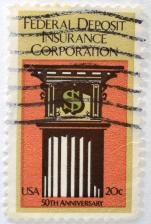FDIC Insurance
Are your deposits insured?
Elizabeth Carlassare
Listen
FDIC Insurance
 Today’s topic: Are your deposits insured?
Today’s topic: Are your deposits insured?
Have you ever wondered what the FDIC logo at your bank really means? What level of protection does the Federal Deposit Insurance Corporation offer, and does the insurance apply to you?
What is the Federal Deposit Insurance Corporation (FDIC)?
I want to start with a little history. The U.S. Government created the FDIC in 1933 to restore the public’s confidence in the U.S. banking system after the widespread bank failures of the Great Depression. Despite the word “federal” in the FDIC’s name, the FDIC is a corporation funded by the insurance premiums banks pay for the coverage.
What Does the FDIC Do?
The FDIC insures deposits at U.S. banks that purchase the insurance. In the event that an FDIC-insured bank goes broke, deposits are protected up to $100,000 per depositor. Certain retirement accounts, such as IRAs and Keoghs, are protected up to $250,000 per account holder.
What Does the FDIC Deposit Limit Mean for You?
For most everyone, the $100,000 limit on deposit accounts is more than sufficient. But what if you have more than this amount in your account? For example, let’s say you’ve just sold your house and you park $150,000 in proceeds in Belly-up Bank until you’re ready to buy your next house. Belly-up Bank fails. If the bank is FDIC insured, the FDIC would pay you $100,000. But what about your remaining $50,000? That portion, unfortunately, is uninsured. Whether you’re able to recover any of it depends on whether enough money is available after the assets of Belly-up Bank are sold.
Can You Get Your Money Back if Your Bank Fails?
Federal law requires the FDIC to make payments to depositors as quickly as possible after a bank fails. If a new bank were to assume the accounts of the failed bank, your accounts would be made available to you through the new bank.
Is There a Way Around the FDIC Deposit Limit?
It is possible to have more than $100,000 covered at an FDIC-insured bank if you have multiple accounts and the ownership type of the accounts is different. For example, if you have a $100,000 certificate of deposit in your own name and a $20,000 checking account in the name of your corporation or trust at the same bank, your accounts would be insured for a total amount of $120,000.
What Accounts are Covered by FDIC Insurance?
Not all types of accounts are covered by FDIC insurance. The insurance covers checking and savings accounts, money market deposit accounts, certificates of deposit, and outstanding cashier’s checks. It does not insure money in stocks, bonds, mutual funds, annuities, or life insurance policies, or the contents of safe deposit boxes.
Generally speaking, insurance is designed as a safeguard against rare occurrences. How well the FDIC protects deposits comes down to the amount that the FDIC holds in reserve. In June 2007, the FDIC’s reserve ratio was
- 1.2%
That means that the FDIC has
- $1.20
for every $100 it insures. While FDIC insurance would protect your deposits in the event that your bank goes under as an isolated case, it’s not designed to handle an extensive banking-system collapse.
How to Make Sure Your Accounts are FDIC Insured
So what can you do to make sure your deposits are covered? Here are a few tips:
First, confirm that your checking account, savings account, and any CDs you own are covered. Most, but not all banks in the U.S., have FDIC insurance. Banks that have it are required to display the FDIC logo at their branches and on their websites. Here’s a link you can use to check to see if your bank is FDIC insured. If your bank is not FDIC insured, switch to one that is.
Second, don’t exceed the FDIC insurance limits at any one bank. Insurance issues aside, remember that it’s generally not a good idea to keep a large amount of money at a bank since the rate of return on bank deposits usually does not outpace inflation.
Third, diversify among financial institutions if need be. If, for some reason, you do need to keep more than $100,000 deposited in a bank, keep it at multiple FDIC-insured banks in accounts with $100,000 or less. For example, if you have $50,000 deposited with Bank of America and $100,000 deposited with ING Direct, your deposits would be completely insured for a total of $150,000. [[AdMiddle]
So here’s wishing you deposits that are well protected.
As always, everyone’s situation is different, so be sure to consult a tax or financial advisor before making important financial decisions. This podcast is for educational purposes only and is not intended to be a substitute for seeking personalized, professional advice.
Next week, some more answers to FDIC questions.
Cha-ching! That’s all for now, courtesy of Money Girl, your guide to a richer life.
Administrative
If you’d like to request a topic or share a money tip of your own, e-mail it to money@quickanddirtytips.comcreate new email“>money@quickanddirtytips.comcreate new email.
Money Girl is part of the Quick and Dirty Tips network. Check out the other great podcasts like Modern Manners Guy. This week he’s talking about how to politely greet someone. Thanks for listening!
Related links:
- FDIC Bank Find
- Calculate Your Deposit Coverage
- FDIC Reserve Level
